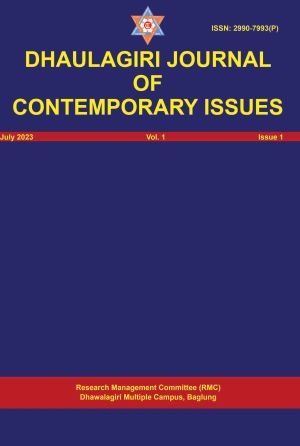Female Subjugation and Resistance in Jean Rhys's Wide Sargasso Sea
DOI:
https://doi.org/10.3126/djci.v1i1.58628Keywords:
colonial domination, marginalization, patriarchal discrimination, resistanceAbstract
Jean Rhys's Portrays the European domination and patriarchal cultural context of Jamaica after the passage of the Emancipation Act (1833). The novelist stages creole characters who are exclusively exploited, subjugated and marginalized in colonial regime. In this respect, the representations of the female characters such as Antoinette, Christophine, Gracepoole, Amelie, Leah, among others clearly display the debased status of females in Jamaica even after the emancipatory proclamation. The novel dramatizes the violence perpetrated on women by the White colonizers even after the colonial rule. Moreover, Rhys projects female characters to expose the humiliating state of women in the novel. Thus, this article proposes to analyze the female body as a subordinated site as well as resistance in the purview of postcolonial feminist theory especially of Gyatri Spivak, Ketu Katrak and Chandra D. Mohanty address the challenges faced by subjugated and marginalized voices in representing themselves within dominant discourses. So, the research draws on the ideas of Spivak’s “Can the subaltern speak?” as the subaltern refers to individuals or groups who are socially, politically, racially, culturally and economically subjugated and silenced by dominant power structure and system. Their feminist stands unbox the exploitation of female and their feeble resistance in the commonwealth countries that this research critically analyzes Rhys’s novel. Imbibing their arguments it further, argues that Wide Sargasso Sea not only revisits the lacuna prevalent in colonial historiography by depicting the colonized people but also clearly points out the marginal representation of female under the ambit of imperial power.
Downloads
Downloads
Published
How to Cite
Issue
Section
License
Copyright (c) 2023 Shyam Prasad Sharma

This work is licensed under a Creative Commons Attribution-NonCommercial 4.0 International License.
This license allows others to use, distribute, and build upon your work, as long as they provide attribution to you as the original creator. However, the license restricts commercial use of the work, meaning others cannot use it for commercial purposes without seeking additional permissions or licensing agreements.




